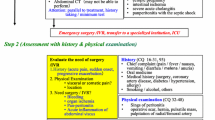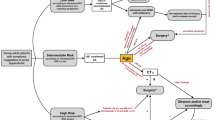Abstract
CECT scan is considered essential for selective non-operative management (SNOM) of patients with abdominal trauma. However, CECT has its own hazards and limitations. We evaluated the safety and efficacy of selective non-operative management of patients with abdominal trauma without the mandatory use of CECT scan in a prospective study. Patients with peritonitis and ongoing intra-abdominal bleed were excluded. Consenting FAST positive, hemodynamically stable patients with blunt and penetrating abdominal trauma between 18 and 60 years of age were included and admitted for SNOM and detailed ultrasonography of the abdomen (in all) with or without CECT abdomen (selectively). Eighty-four patients with abdominal trauma were admitted during the study period. Twenty-two patients did not satisfy the inclusion criteria and 18 required immediate laparotomy based on primary survey. Remaining 44 patients were admitted for SNOM: mean ± SD age of these patients was 27 ± 8.7 years; 40 (89 %) were males. Thirty-five patients (79.54 %) sustained blunt trauma (RTI = 16, Fall = 16, others = 3) while nine patients (20.45 %) sustained penetrating trauma. SNOM without CECT was successful in 36 (81.82 %) patients. Five (11.36 %) patients underwent delayed emergency laparotomy based on clinical and detailed USG evaluation. CECT was not done in these patients. Three patients underwent CECT for various reasons; however, they were managed with SNOM. Thus, SNOM without abdominal CECT was successful in 36 (81.82 %) patients. SNOM failed in five patients but abdominal USG was sufficient. SNOM can be practised safely in patients of abdominal trauma with limited use of CECT scan.
Similar content being viewed by others
References
Stawicki SP (2007) Trends in non operative management of traumatic injuries: a synopsis. OPUS 12 Scientist 1:19–35
Schwab CW (2001) Selection of nonoperative management candidates. World J Surg 25:1389–1392
Knudson MM, Maull KI (1999) Nonoperative management of solid organ injuries. Past, present, and future. Surg Clin North Am 79:1357–1371
Hawkins ML, Wynn JJ, Schmacht DC, Medeiros RS, Gadacz TR (1998) Nonoperative management of liver and/or splenic injuries: effect on resident surgical experience. Am Surg 64:552–556
Goan Y, Huang M, Lin M (1998) Nonoperative management for extensive hepatic and splenic injuries with significant hemoperitoneum in adults. J Trauma 45:360–364
Isenhour JL, Marx J (2007) Advances in abdominal trauma. Emerg Med Clin North Am 25:713–733
Ertekin C, Yanar H, Tariloglu K, Guloglu, Alimoglu O (2005) Unnecessary laparotomy by using physical examination and different diagnostic modalities for penetrating abdominal stab wounds. Emerg Med J 22:790–794
Muckart DJJ, Abdool-Carrim ATO, King B (1990) Selective conservative management of abdominal gunshot wounds: a prospective study. Br J Surg 77:652–655
Demetriades D, Charalambides D, Lakhoo M, Pantanowitz D (1991) Gunshot wounds of the abdomen: role of selective conservative management. Br J Surg 78:220–222
Navsaria PH, Berli JU, Edu S, Nicol AJ (2007) Non-operative management of abdominal stab wounds—an analysis of 186 patients. S Afr J Surg 45:128–130
Arikan S, Kocakusak A, Yucel AF, Adas G (2005) A prospective comparison of selective observation and routine exploration methods for penetrating abdominal stab wounds with organ or omentum evisceration. J Trauma 58:526–532
Fikry K, Velmahos GC, Bramos A, Janjua S, de Moya M, King DR, Alam HB (2011) Successful selective non-operative management of abdominal gunshot wounds despite low penetrating trauma volumes. Arch Surg 146:528–532
Pryor JP, Reilly PM, Dabrowski GP, Grossman MD, Schwab CW (2004) Nonoperative management of abdominal gunshot wounds. Ann Emerg Med 43:344–353
Hoff WS, Holevar M, Nagy KK, Patterson L, Young JS, Arrillaga A et al (2002) Practice management guidelines for the evaluation of blunt abdominal trauma: the East practice management guidelines work group. J Trauma 53(3):602–615
Como JJ, Bokhari F, Chiu WC, Duane TM, Holevar MR, Tandoh MA et al (2010) Practice management guidelines for selective non-operative management of penetrating abdominal trauma. J Trauma 68(3):721–733
Raza M, Abbas Y, Devi V, Prasad KV, Rizk KN, Nair PP (2013) Non operative management of abdominal trauma—a 10 years review. World J Emerg Surg 8:14. doi:10.1186/1749-7922-8-14, eCollection 2013
Soto JA, Anderson SW (2012) Multidetector CT of blunt abdominal trauma. Radiology 265(3):678–693
Mathews JD, Forsythe AV, Brady Z, Buler MW, Georgen SK, Brynes GB et al (2013) Cancer risk in 680,000 pople exposed to computed tomography scans in childhood or adolescence: datalinkage study of 11 million Australians. BMJ 346:f2360. doi:10.1136/bmj.f2360
Shah NB, Platt SL (2012) ALARA: is there a cause for alarm? Reducing radiation risks from computed tomography scanning in children. Curr Opin Pediatr 20(3):243–247
(2012) Abdominal and pelvic trauma. In: Advanced Trauma Life Support student course manual 9th edition. Chicago. p. 122–140
Weigelt JA, Kingman RG (1988) Complications of negative laparotomy for trauma. Am J Surg 156:544–550
Demetriades D, Velmahos G (2003) Technology-driven triage of abdominal trauma: the emerging era of non operative management. Annu Rev Med 54:1–15
Deunk J, Dekker HM, Brink M, Vugt R, Edwards MJ, Vugt AB (2007) The value of indicated computed tomography scan of the chest and abdomen in addition to the conventional radiologic work-up for blunt trauma patients. J Trauma 63:757–763
Nural MS, Yardan T, Guven H, Baydin A, Bayrak IK, Kati C (2005) Diagnostic value of ultrasonography in the evaluation of blunt abdominal trauma. Diagn Interv Radiol 11:41–44
Sirlin CB, Brown MA, Andrade-Barreto OA, Deutsch R, Fortlage DA, Hoyt DB, Casola G (2004) Blunt abdominal trauma: clinical value of negative screening US scans. Radiology 230:661–668
Author information
Authors and Affiliations
Corresponding author
Ethics declarations
Conflict of Interest
The author and all co-authors declare that they have no conflict of interest.
Rights and permissions
About this article
Cite this article
Kumar, S., Prakash, P., Joshi, M.K. et al. Selective Non-operative Management of Patients with Abdominal Trauma—Is CECT Scan Mandatory?. Indian J Surg 79, 396–400 (2017). https://doi.org/10.1007/s12262-016-1494-x
Received:
Accepted:
Published:
Issue Date:
DOI: https://doi.org/10.1007/s12262-016-1494-x




